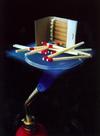 On Jan. 2, NASA’s Stardust spacecraft flew through a 14,000-mile-an-hour hail of debris from the Wild 2 comet. Under this withering barrage, the ship’s objective was not only to survive, but to use a collector made of a bizarre substance to gather an unaltered sample of five-billion-year-old dust and gas ejected by the comet. NASA is using a substance called ‘aerogel’ in the Stardust spacecraft to catch pieces of the Wild-2 comet.
On Jan. 2, NASA’s Stardust spacecraft flew through a 14,000-mile-an-hour hail of debris from the Wild 2 comet. Under this withering barrage, the ship’s objective was not only to survive, but to use a collector made of a bizarre substance to gather an unaltered sample of five-billion-year-old dust and gas ejected by the comet. NASA is using a substance called ‘aerogel’ in the Stardust spacecraft to catch pieces of the Wild-2 comet.
The NYT is running an article about some other amazing aerogel properties. My favourite quote about aerogel: ‘It’s the lowest density of any solid, and it has the highest thermoinsulation properties. Though it would be very expensive, you could take a two or three bedroom house, insulate it with aerogel, and you could heat the house with a candle. But eventually the house would become too hot.’

 At around 0.003 grams per cubic centimetre of material, only about three times as dense as air, aerogel is pure silicon dioxide. Not only is it the least dense solid in existence, it is also such a remarkable insulator that a layer of it surrounds the most vital electronics on all the Mar’s rovers. But the most striking feature, at least to the naked eye, is that up close, the cube looks like a blurry hologram.
At around 0.003 grams per cubic centimetre of material, only about three times as dense as air, aerogel is pure silicon dioxide. Not only is it the least dense solid in existence, it is also such a remarkable insulator that a layer of it surrounds the most vital electronics on all the Mar’s rovers. But the most striking feature, at least to the naked eye, is that up close, the cube looks like a blurry hologram.
“When you look at this,” says Dr. Tsou, holding the aerogel up, “you don’t know where to focus. That’s why some people call it solid smoke.”
For more information on Aerogel and it’s amazing qualities, check out the following NASA link. Stardust Technology: Aerogel
One thing NASA doesn’t reveal is that aerogel is not a new discovery… the first aerogels were prepared in 1931.
